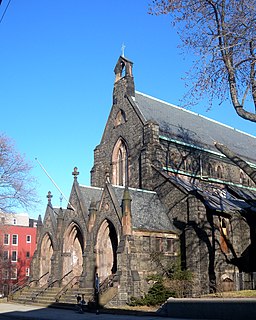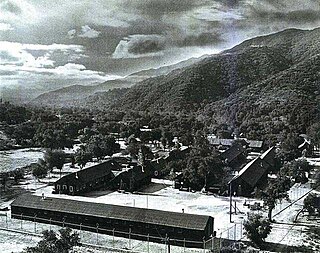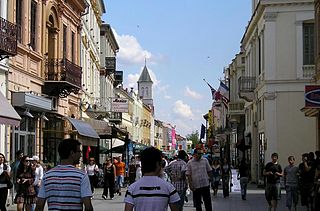
Boyle Heights is a neighborhood of almost 100,000 residents east of Downtown Los Angeles in the City of Los Angeles, California. The district has more than 20 public schools and 10 private schools.

Whittier is a neighborhood in the U.S. city of Minneapolis, Minnesota, bounded by Franklin Avenue on the north, Interstate 35W on the east, Lake Street on the south, and Lyndale Avenue on the west. It is known for its many diverse restaurants, coffee shops and Asian markets, especially along Nicollet Avenue. The neighborhood is home to the Minneapolis Institute of Art, the Minneapolis College of Art and Design, and the Children's Theatre Company.

The Jefferson Market Branch of the New York Public Library, once known as the Jefferson Market Courthouse, is located at 425 Avenue of the Americas, on the southwest corner of West 10th Street, in Greenwich Village, Manhattan, New York City, on a triangular plot formed by Greenwich Avenue and West 10th Street. It was originally built as the Third Judicial District Courthouse from 1874 to 1877, and was designed by architect Frederick Clarke Withers of the firm of Vaux and Withers.

The Pellissier Building and adjoining Wiltern Theatre is a 12-story, 155-foot (47 m) Art Deco landmark at the corner of Wilshire Boulevard and Western Avenue in Los Angeles, California. The entire complex is commonly referred to as the Wiltern Center. Clad in a blue-green glazed architectural terra-cotta tile and situated diagonal to the street corner, the complex is considered one of the finest examples of Art Deco architecture in the United States. The Wiltern building is owned privately, and the Wiltern Theatre is operated by Live Nation's Los Angeles division.

José Luis Huizar is an American elected official in California. He is a member of the Los Angeles City Council representing District 14.

The Eastern Columbia Building, also known as the Eastern Columbia Lofts, is a thirteen story Art Deco building designed by Claud Beelman located at 849 S. Broadway in the Broadway Theater District of Downtown Los Angeles. It opened on September 12, 1930 after just nine months of construction. It was built at a cost of $1.25 million as the new headquarters and 39th store for the Eastern Outfitting Company and the Columbia Outfitting Company, furniture and clothing stores founded by Adolph Sieroty and family. At the time of construction, the City of Los Angeles enforced a height limit of 150 feet, however the decorative clock tower was granted an exemption, allowing the clock a total height of 264 feet.

The Los Angeles Conservancy is a historic preservation organization in Los Angeles, California. It works to document, rescue and revitalize historic buildings, places and neighborhoods in the city. The Conservancy is the largest membership based historic preservation organization in the country. The group was formed in 1978 to preserve Los Angeles Central Library, which was threatened with demolition. The organization has over 7000 members and 400 volunteers. There is a volunteer Modern Committee, dedicated to the preservation of postwar architecture as well as a Historic Theaters Committee that produces the annual "Last Remaining Seats" film series of classic films in the historic movie palaces in downtown Los Angeles. The executive director since 1992 has been Linda Dishman. The Conservancy hosts an annual preservation awards ceremony at the Millennium Biltmore Hotel and works closely with the business, political and development communities to find preservation solutions for historic buildings. https://www.tripadvisor.com/Attraction_Review-g32655-d2227049-Reviews-Los_Angeles_Conservancy_Walking_Tours-Los_Angeles_California.html Some of the Conservancy's biggest success stories have included Bullocks Wilshire, the Cathedral of Saint Vibiana, the Wiltern Theater and the oldest operating McDonald's in Downey, CA.

Golden Gate Theater is a Spanish Baroque Revival Churrigueresque-style movie palace built in 1927 on Whittier Boulevard in East Los Angeles, California. In 1982, it was listed on the National Register of Historic Places. The theater closed in 1986; the retail building built around it was damaged in the 1987 Whittier Narrows earthquake and demolished in 1992. The remaining theater building was left vacant for more than 20 years as preservationists fought with owners and developers over the future of the building. It was finally converted into a drugstore and reopened in 2012.

Wiss, Janney, Elstner Associates, Inc. (WJE) is an American corporation of architects, engineers, and materials scientists specializing in the investigation, analysis, testing, and design of repairs for historic and contemporary buildings and structures. Founded in 1956, WJE is headquartered in Northbrook, Illinois, and has over 600 professionals in twenty offices across the United States. WJE personnel are specialized in architectural, structural, and civil engineering; materials conservation, chemistry and petrography, and testing and instrumentation.

The New York Landmarks Conservancy is a non-profit organization "dedicated to preserving, revitalizing, and reusing New York’s architecturally significant buildings." It provides technical assistance, project management services, grants, and loans, to owners of historic properties in New York State. Since its founding, the Conservancy has provided more than $40 million in grants and loans.

There are 65 properties listed on the National Register of Historic Places in Albany, New York, United States. Six are additionally designated as National Historic Landmarks (NHLs), the most of any city in the state after New York City. Another 14 are historic districts, for which 20 of the listings are also contributing properties. Two properties, both buildings, that had been listed in the past but have since been demolished have been delisted; one building that is also no longer extant remains listed.

The Fred C. Nelles Youth Correctional Facility was in essence a prison for youth located on Whittier Boulevard, in Whittier, California. Operated by the California Youth Authority, now part of California Department of Corrections, it once quartered young people incarcerated for law-breaking until it was closed by the state of CA in June 2004. Open for 113 years, it had been the oldest juvenile facility in the state, and became registered as California Historical Landmark #947. It was closed because of the reduction in the number of juveniles being housed.
The San Buenaventura Conservancy is an historic preservation organization in Ventura, California also known by its early name of San Buenaventura. It works to recognize and revitalize historic, archeological and cultural resources in the region. The Conservancy is a membership based historic preservation non-profit 501c3 organization. The group was formed in 2004 after the demolition of the Mayfair Theater, an S. Charles Lee, Streamline Moderne, movie theater in downtown Ventura, California that was razed and replaced with a condo project.

Lincoln Place Apartment Homes is a historic apartment community owned by a subsidiary of Apartment Investment and Management Co. (Aimco). Inspired by the garden city movement, it is located at 1050 Frederick Street on a 35-acre site in the Venice community of Los Angeles, one mile east of Venice Beach. Built from 1949-1951, the property is just off Lincoln Boulevard, bound by Lake Street and Penmar Avenue with Elkgrove Avenue and Elkgrove Circle within its interior.

Saint John's Episcopal Church in Jersey City, New Jersey is located on Summit Avenue in Bergen Hill. Owned by the Episcopal Diocese of Newark, it is considered a masterwork of 19th-century ecclesiastical architecture. The building, which has fallen into disrepair, became a municipal landmark in 2013.
Andrew Berman is an architectural and cultural heritage preservationist in New York City. He is known for being an advocate of affordable housing and LGBT rights. Berman was named executive director of the Greenwich Village Society for Historic Preservation (GVSHP), neighborhood preservation organization in New York City, in 2002.

Tuna Canyon Detention Station was a temporary detention facility used for holding enemy aliens who were considered by the U.S. government to be risks to national security. The detention camp was located in Tujunga at a former Civilian Conservation (CCC) Camp, constructed in 1933. The camp was converted into the Tuna Canyon Detention Station just after the bombing of Pearl Harbor. Administered by the Department of Justice, it opened on December 16, 1941, when the first group of detainees arrived from various Southern California towns and cities. Tuna Canyon had a capacity of 300, and until its closing in October 31, 1943, over 2,000 Japanese, German, and Italian immigrants, Japanese Peruvians, and others were imprisoned there. Most were transferred to other DOJ facilities like Fort Missoula, Fort Lincoln and Santa Fe. The site was used as a probation school after the war.


















